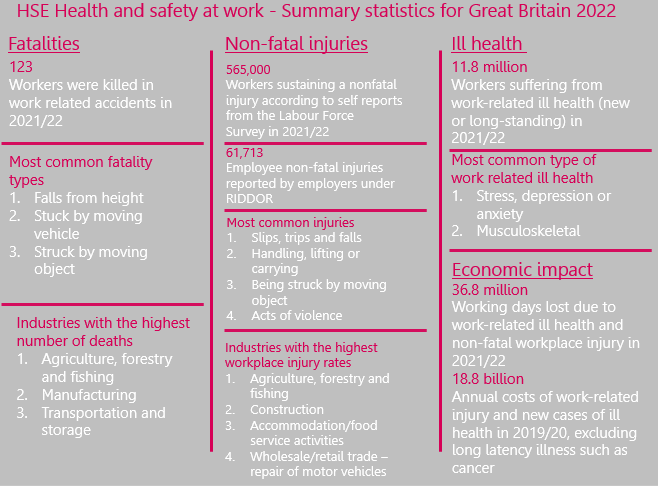Ill health
1.8 million workers suffered from work-related ill health (new or longstanding) in 2021/22, which is up almost 6% from the previous year. Stress, depression or anxiety remained the highest proportion of work-related ill health (51% 914,000), followed by musculoskeletal disorders (27% 477,000).
Workplace injuries and fatalities
565,000 workers reportedly sustained non-fatal injuries at work in 2021/22, an increase from 441,000 in 2020/21, which could be as a result of more people returning to work after the pandemic but it is important to note this figure is still lower than pre-pandemic figures.
RIDDOR reports for non-fatal injuries have also increased from 51,211 in 2020/21 to 61,713 in 2021/22.
By sector, agriculture, forestry and fishing, construction, accommodation/food service activities and wholesale/retail trade - repair of motor vehicles had higher workplace injury rates compared to the average across all industries.
The most common causes of injuries to employees included slips, trips or falls (30%), handling, lifting or carrying (18%), being struck by a moving object (11%), acts of violence (9%) and falls from height (8%).
123 workers died as a result of work related accidents which was a decrease from 142 in 2020/21.
The industries with the highest number of deaths were construction (30), agriculture, forestry and fishing (22) and manufacturing (22), as confirmed in the HSE's workplace fatality figures that were published in July 2022. These three sectors, with the addition of transportation and storage (16), accounted for 73% of fatal injuries. Agriculture, fishing and manufacturing had the highest rate of fatal injury per 100,000 workers.
The most common cause of death at work across all sectors continues to be falls from height (29) and workers being struck by moving vehicles (23) or moving, falling or flying objects (18).
The economic cost
The statistics revealed that an astounding 36.8 million working days were lost due to work-related ill health and non-fatal workplace injury in 2021/22 and the annual cost of work related injury and new cases of ill health cost £18.8 billion in 2019/20, £3.5 billion of which was stomached by employers.
Conclusions
Employers need to be mindful that ill health, in particular stress, depression and anxiety, can be caused or worsened by the workplace and should be considering this as they would any other workplace hazard.
Whilst the number of injuries to workers is lower than pre-pandemic levels, the decrease seen in 2020/21 has not been maintained in 2021/22, which suggests perceived improvements may have in reality been down to the pandemic and fewer people working, which was somewhat expected to be the case.
This year saw a decrease in fatalities in the workplace which suggests a positive step in the right direction, but the overall number of worker deaths is still high and broadly in line with pre-pandemic levels. It therefore remains that all industries need to continue to make improvements with a view to making workplaces a safer place.
DWF's Tier 1 Regulatory, Compliance and Investigation Team has the knowledge and experience to assist you with improving health and safety at your business. DWF's experienced Crisis Management Team can also help you with all aspects of Crisis Management, from crisis planning and training, to response, reputational management and recovery in the event of an incident.
Find out more information about our Crisis and Incident Management Service
If you have any queries regarding the topics raised in this article, please do not hesitate to get in touch with the contact below to discuss issues further.
Read the latest Regulatory, Compliance and Investigations Insights
















